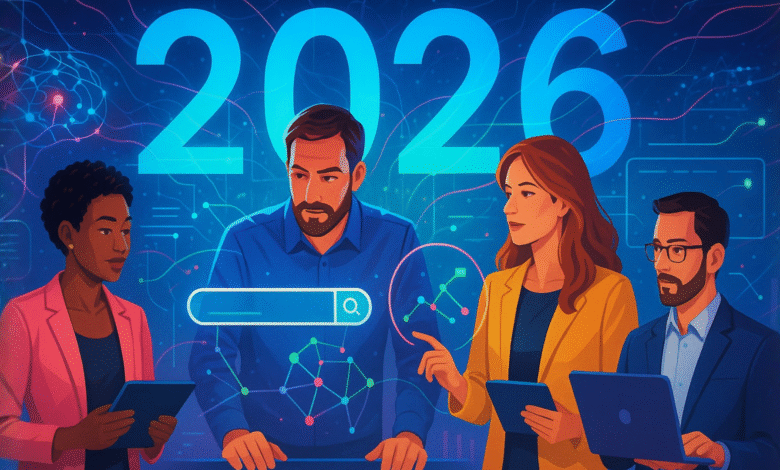7 Key AI Focus Areas Reshaping Search in 2026

▼ Summary
– AI-powered search is fundamentally transforming search by 2026, with AI assistants expected to handle 25% of global queries and collapsing the traditional customer journey.
– Marketers must adopt new strategies like answer engine optimization (AEO) and generative engine optimization (GEO) to build strong content and experience flywheels for AI visibility.
– AI search is shifting from query-and-response to dynamic conversations, delivering direct answers and enabling action-oriented tasks like bookings and purchases without website visits.
– Brands need integrated, omnichannel systems and must serve as trusted data sources for AI, prioritizing structured content and seamless data accessibility over being a destination.
– Success in AI-driven search requires redefining KPIs to focus on AI visibility, citation counts, and share of voice, while strengthening technical foundations for AI retrievability.
The digital search landscape is undergoing a seismic transformation, with artificial intelligence fundamentally reshaping how users discover information and make decisions. By 2026, AI-powered assistants and large language models are projected to manage approximately one quarter of all global search queries, signaling a dramatic departure from traditional search behaviors. This evolution collapses the classic customer journey, reducing touchpoints by half and accelerating the path from initial interest to final conversion.
We are already witnessing the initial effects of this shift. Traffic originating from LLMs is increasing at an exponential rate, highlighting a profound change in information discovery habits. For marketers, maintaining a competitive edge now depends on building powerful content and experience flywheels. Answer engine optimization and generative engine optimization are becoming critical priorities in this new environment.
Industry expert Bruce Clay foresees a significant impact, noting that AI-powered search will likely cause a continued decline in traffic for numerous websites, creating a major disruption. Adopting AI is no longer an optional upgrade but a foundational requirement for survival. However, most existing marketing systems were not designed to function in an AI-first world. Disconnected tools and isolated data create operational difficulties and inconsistencies that severely hinder performance. To succeed in the coming years, brands will need integrated, cross-functional, omnichannel systems that seamlessly connect data, content, and the overall customer experience.
Building a resilient digital presence for an AI-driven future requires a complete re-evaluation of data management, tool selection, and customer interaction models, all while presenting a cohesive and consistent brand narrative. The objective is to deliver highly personalized content and prepare for agentic experiences, where AI assistants actively perform tasks on the user’s behalf.
This transformation begins with the core mechanics of search itself. The most significant change is the move away from a simple query-and-response model toward a more dynamic, reasoning-driven conversation. If traditional search resembled a structured game of chess, AI search is more akin to an improvised jazz performance—continuous and fluid. The user experience has shifted from browsing through lists of links and visiting various websites to receiving direct, synthesized answers.
Instead of merely matching keywords to a pre-existing index, AI utilizes a process called query fan-out. This involves deconstructing a query into its fundamental components, analyzing a multitude of sources, and then delivering a single, comprehensive answer based on recognized patterns. Consequently, the traditional marketing funnel is shrinking. AI search can propel a user directly from expressing intent to completing a conversion in a matter of minutes, dramatically speeding up the entire process. Early data indicates conversion rates from AI search traffic are already three to eight times higher than from other sources.
According to Crystal Carter of Wix, traffic from LLMs is developing its own distinct characteristics compared to traditional Google search traffic, necessitating separate optimization and analysis strategies. New categories of user intent, such as “generative” requests and conversational pleasantries, now constitute nearly half of all LLM interactions and typically do not result in a website visit. Search is becoming inherently action-oriented. As AI systems begin to book reservations, schedule appointments, and finalize purchases, even transactional journeys may no longer conclude on a brand’s website.
The concept of ‘search everywhere’ optimization represents the new frontier of SEO. For modern brands, the goal is no longer to function as a single destination but to maintain a presence wherever their audience is active. This means becoming a trusted data source that fuels the emerging agentic ecosystem. Since AI systems prioritize clarity, consistency, and recognizable patterns, isolated channel strategies must be replaced by a well-integrated, omnichannel approach. The ideal scenario allows AI agents to access all relevant brand data to deliver complete and contextually accurate results based on user intent.
Bill Hunt of Back Azimuth Consulting elaborates that AI agents are evolving from simply answering questions to completing full transactions. The growing importance of APIs and integrations for platforms like Shopify, Walmart, and Amazon means that being “callable” by AI systems will be as crucial in 2026 as being “crawlable” was over a decade ago. In this new paradigm, websites are transforming from primary sales destinations into robust data and information repositories—built not only for human visitors but also for the AI systems that retrieve, interpret, and act upon that information.
To remain competitive in 2026 and beyond, brands must optimize for visibility across every relevant platform. Here are seven key priorities and emerging trends that will define the future of search and marketing technology.
1. Strengthen technical SEO foundations for AI retrievability The foundational principle of search is shifting from traditional crawlability to generative engine optimization. The core of GEO is retrievability—ensuring that high-quality content is not only discoverable but also easily accessible and comprehensible to AI models. To prepare, your website should function as a centralized data hub for all content and digital assets, enhancing the experience for both human users and AI systems. Essential steps include granting access to AI crawlers via your robots.txt file, utilizing server-side rendering for core content, and adopting progressive indexing protocols like IndexNow.
2. Build localized visibility in AI-driven environments Local SEO has progressed through several phases and is now entering a new era of personalized experiences. AI models, particularly those used by major search engines, increasingly pull local business information from sources like Google Maps and online directories. This makes foundational local SEO practices—such as maintaining NAP consistency and optimizing Google Business Profiles—absolutely critical for sustaining AI visibility. Webpages with robust schema markup also tend to achieve higher citation rates in AI overviews, reinforcing the vital importance of structured data for local relevance.
3. Develop an AI-assisted content flywheel The primary challenge today extends beyond content creation to building a truly connected user experience. As companies integrate AI into their digital experience platforms, the focus must shift from producing isolated assets to constructing a cohesive content flywheel. This begins with a profound understanding of your customers’ identities and needs, enabling you to fill content gaps in real-time and maintain presence at every critical touchpoint. Modern DXPs are evolving from static repositories into intelligent, AI-native engines that proactively shape user journeys.
The ideal platform leverages AI to generate quality content at scale, powering a flywheel that delivers personalized, efficient, and well-governed customer experiences. This is particularly vital for large brands and multi-location businesses, where updating hundreds of pages often remains a manual and repetitive task. The process involves several key stages:
- Insights: Use AI-powered tools to uncover audience questions and challenges, then analyze existing content to identify gaps.
- Creation: Use AI, with human oversight, to scale the development of deep, comprehensive, and machine-readable content across text, images, and video. Prioritize an entity-based SEO strategy to build topical authority and use comprehensive schema markup.
- Distribute: Establish a human-in-the-loop workflow for regular content review and updates. Publish from a centralized source for cross-channel consistency and adopt rapid indexing protocols.
- Monitor and Iterate: Continuously track visibility within AI models, deploy an agile strategy, and refine your approach based on performance data to create a self-sustaining flywheel.
As Bill Hunt notes, AI search engines synthesize information across entire ecosystems, not just individual pages. Marketing leaders must ensure their digital footprint operates as a unified system. This shift is moving focus from traditional SEO to relevance engineering—a discipline centered on systematically creating and structuring content for maximum semantic relevance.
4. Create a consistent, data-driven experience flywheel While the content flywheel attracts visitors, the experience flywheel is responsible for converting them—a function that is critically important in an era of zero-click searches. It operates on a continuous feedback loop:
- Strategy: Build your experience strategy using unified data from every customer touchpoint. Use AI to segment this data, revealing audience expectations and friction points to shape a strategy grounded in real user behavior.
- Experience: Leverage AI to connect audience intent, personas, desired outcomes, and business goals, generating predictive insights that drive personalized and agentic experiences dynamically.
- Conversion: Use AI to track the customer journey across channels. Conduct dynamic A/B testing and conversion rate optimization at scale, tailored to specific audience segments and intents.
- Iteration: Focus on agility over perfection. Use performance data to make real-time adjustments, continuously refining your strategy with each new insight.
The experience flywheel becomes a self-reinforcing engine that drives engagement, builds loyalty, and accelerates growth.
5. Use AI agents to orchestrate journeys and workflows As AI-driven search becomes more agentic, it establishes a new benchmark for the seamless digital experiences customers now expect. To meet this demand, brands must implement journey orchestration and workflow automation powered by AI agents that guide users through connected, intuitive experiences. The key is deploying specialized vertical AI agents trained on your specific business data. By orchestrating these agents across the customer journey, you can deliver hyper-personalized, omnichannel experiences. For internal teams, these agents also present significant opportunities to automate manual workflows across the entire marketing landscape.
6. Redefine KPIs for an AI-first performance model As AI satisfies user intent more directly within search interfaces, traditional metrics like keyword rankings and organic traffic are losing their significance. This evolution means that citation is effectively the new rank, pushing teams to optimize content for retrievability above all. As click-through rates decline in importance, new success indicators are emerging, including LLM visibility scores, AI citation counts, share of voice, and sentiment analysis. Success now heavily depends on query diversity—the ability to effectively answer a wide range of related long-tail queries.
Ray Grieselhuber of Demandsphere advises that while traditional metrics remain somewhat useful, marketers should renew their focus on human behavior, with Share of Voice being one of the best KPIs to measure this new dynamic. Companies that ignore their visibility in AI-driven responses risk ceding that territory to competitors.
7. Integrate systems and data to power a unified marketing infrastructure A fragmented marketing technology stack with siloed tools creates operational inefficiencies and hidden costs. Data fragmentation and manual processes increase operational expenses and derail integration efforts. Shifting focus to an integrated marketing platform—and carefully evaluating the total cost of ownership—helps overcome these challenges. An integrated solution provides the consistency, clarity, and unified data foundation required to keep your digital presence both adaptive and competitive.
As we advance toward 2026, AI is not merely another tool in the marketer’s kit; it is reconstructing the customer journey from the ground up. With AI assistants slated to handle a significant portion of search queries, the traditional marketing funnel is contracting. The new landscape is defined by agentic, action-oriented interactions that can completely bypass websites, demanding a fundamental strategic shift from every brand.
To maintain visibility and relevance, businesses must evolve from being destinations to becoming trusted data sources for AI. This begins by fueling a content flywheel with deep, structured content that is accessible across every channel. Once this flywheel successfully attracts an audience, an experience flywheel—powered by unified customer data and an integrated, AI-native platform—takes over to drive conversion through deep personalization.
Ultimately, the brands that will thrive are those that fully embrace this new ecosystem. They will replace outdated metrics with new KPIs focused on AI visibility, dismantle organizational silos through strategic integration, and make the delivery of seamless, omnichannel experiences their highest priority.
(Source: Search Engine Land)





